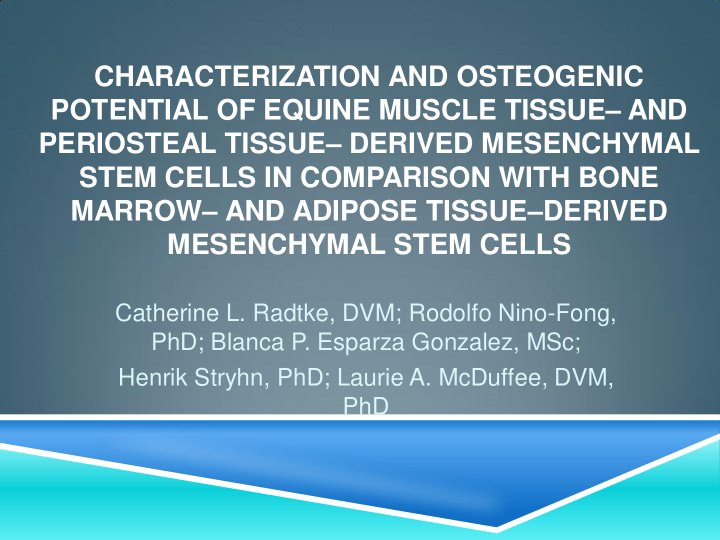



CHARACTERIZATION AND OSTEOGENIC POTENTIAL OF EQUINE MUSCLE TISSUE – AND PERIOSTEAL TISSUE – DERIVED MESENCHYMAL STEM CELLS IN COMPARISON WITH BONE MARROW – AND ADIPOSE TISSUE – DERIVED MESENCHYMAL STEM CELLS Catherine L. Radtke, DVM; Rodolfo Nino-Fong, PhD; Blanca P. Esparza Gonzalez, MSc; Henrik Stryhn, PhD; Laurie A. McDuffee, DVM, PhD
WHAT ARE MESENCHYMAL STEM CELLS? Mesenchymal stem cells, also know as MSCs, are multipotent stromal cells that can differentiate into a variety of cell types. They are essential in the world of medicine because they can differentiate into multiple lineage cells including adipocytes, chondrocytes, and osteoblasts. Mesenchymal stem cells are classically derived from bone marrow, but research is being done to determine if there is another, possibly better place of origin for mesenchymal stem cells. Mesenchymal stem cells are an option for clinical application because they can be effectively isolated and expanded with high efficiency.
WHAT IS OSTEOGENIC POTENTIAL? WHY IS IT IMPORTANT? The cell’s potential to regenerate bone Tendonitis vs Injuries that are more bone related
EQUINE MUSCLE TISSUE- AND PERIOSTEAL TISSUE- DERIVED MSC VS EQUINE BONE MARROW- AND ADIPOSE TISSUE- DERIVED MSC
WHY IS THIS SIGNIFICANT IN EQUINE MEDICINE? In the world of horses, fractures can be fatal. Recovery Time + Full Recovery Better Investment
WHAT IS THE HYPOTHESIS OF THIS PAPER? We hypothesized that equine periosteum and skeletal muscle are equivalent, if not superior, multipotent sources of MSCs with osteogenic potential, compared with results for the conventionally chosen donor tissues of fat and bone marrow. We hypothesized that muscle- and periosteum- derived MSCs would have proliferative capacity and osteogenic potential equal to or greater than that of bone marrow – and adipose-derived MSCs.
METHODS Collect sample Samples Cryopreservation Cell isolation by the technique of enzyme digestion Cell culture Cell Passage Characterization of MSCs — Cells from each tissue were maintained for 1 week in standard medium. After this period, adherence to the flask and spindle-shaped morphology were confirmed.
CELL DIFFERENTIATION Cells from each tissue were induced to differentiate into adipocytes, chondrocytes, and osteoblasts. Adipocytes: Primarily compose adipose tissue (lipid droplets) Chondrocytes: cells found in healthy cartilage Osteoblasts: Bone forming cells
FLOW CYTOMETRY ANALYSIS FOR MSC SURFACE MARKERS Cells were stained with surface cells markers Antibodies CD34, CD44, CD45, CD90, CD105, CD146r; CD34, CD44, CD45 The analysis results were very clear for 3 cell surface antigens CD44 CD90 CD45 MSCs strongly express CD90, weakly express CD44, and do not express CD 45
According to the International Society of Cellular Therapy, mesenchymal stem cells show positive expression of CD73, CD90 and CD105 and negative expression for CD11b, CD15, CD19, CD79a, CD34, CD45, HLA-DR and other lineage-negative surface antigens.
WHAT IS THE CONCLUSION OF THIS PAPER? First study to confirm osteocalcin expression in MSCs derived from equine muscle and periosteum tissues Equine muscle and periosteum tissues are sources of MSCs Equine muscle and periosteal tissue are a source of potential treatment in bone healing!
Recommend
More recommend